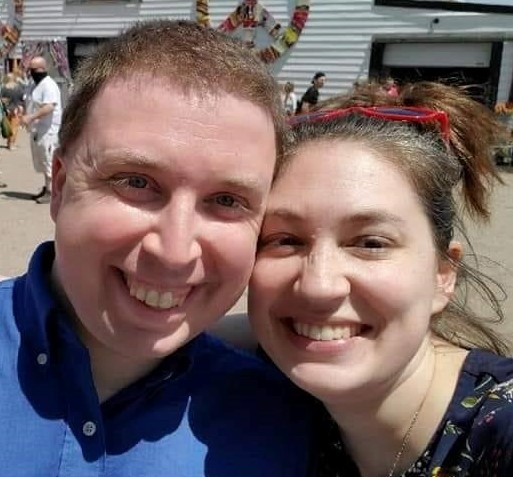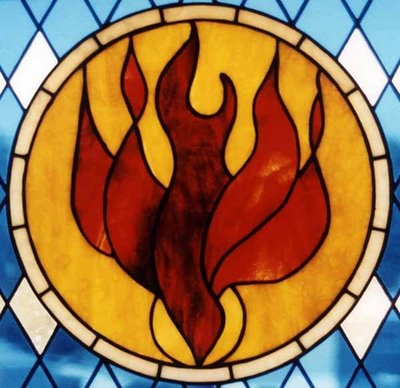By Deacon Timothy Siburg
Revised Common Lectionary
Reflection, Pentecost, Year A
Click
here for the lessons
May 28, 2023
Key Verse: “Receive the Holy Spirit” (John 20:22).
I grew up in the Pacific Northwest. A land of beauty, mountains, water, and generally moderate temperatures with occasional wind gusts that naturally come with rainstorms. This wind, however, did not prepare me for what life would be like living in Nebraska. The wind in Nebraska, where I live now, is hard to describe. It blows where it chooses, seemingly from all directions. Because of that, it’s an apt depiction of the Holy Spirit. Add in the occasional tornado threat, as we had here last week, and one has new appreciation for the creative wonder, upheaval, destruction, and change that the Holy Spirit can bring.
In this week’s stories, the season of Easter has ended, and the time of Pentecost is just beginning. The Holy Spirit arrives on the scene, and nothing will ever be the same. What is clear is that the Holy Spirit is itself a gift. One, as Jesus says to the disciples in John’s version of the story, that they simply were breathed upon as Jesus commands, “Receive the Holy Spirit” (John 20:22).
This isn’t as dramatic as the story of Pentecost from Acts, but it’s powerful nonetheless. Because we are reminded here that it is God who is at work. That God will work with, though, and for God’s own. And that God’s creative, redeeming, and reconciling work continues today through the gift and presence of the Spirit. This is a gift, which in stewardship language is an important insight. The Holy Spirit, one of the three persons of the Trinity, is God’s ongoing presence in the world. A presence promised by Jesus, and a gift which cannot be earned. But this gift and presence is not always something that brings comfort, because its very presence means change.
The Pentecost story in Acts always catches my imagination. The disciples were all together. And then there’s this “violent wind,” “divided tongues, as of fire,” and speaking in other languages (Acts 2:1-4). If that’s not enough, all the people from every nation began to hear the Good News in their own language. That’s something only God can do. And God does it, and does it through and with God’s people. Much in the same way, we hear this week how through the Spirit God shows up in the priesthood of all believers through the various vocations and gifts of all the Children of God in the second lesson from 1 Corinthians 12.
The story in Acts isn’t done, though. As the people begin to try and make sense of it all, there’s a question that stands out. In the awe, amazement and wonder in response to what God might be up to, the people who witness and experience this world-changing Pentecost day ask, “What does this mean?” (Acts 2:12). No, Martin Luther was not the first to ask this question so dramatically. Here the people are curious about what God is up to and inviting next. In response to the question Peter testifies, quoting the prophet Joel. I am particularly drawn to the idea that some in the community will “dream dreams” (Acts 2:17). What dreams might God be inviting you to dream? What dreams might God be inviting the People of God to dream, imagine, and work to be part of? These are questions about mission, discipleship, and stewardship. Either one of them might make for a powerful sermon in your context.
The Acts lesson concludes with Peter saying, “Then everyone who calls on the name of the Lord shall be saved” (Acts 2:21). This is a reminder of God’s work, gifts and promises for God’s people. We hear these weekly in worship, but in the Pentecost readings for this year there seems to be a ton. Consider these from the other three stories in the pericope:
The psalmist reminds us that God provides: “These all look to you to give them their food in due season; when you give to them, they gather it up; when you open your hand, they are filled with good things.” (Psalm 104:27-28).
There is a reminder that it is God through the Spirit who creates: “When you send forth your spirit, they are created; and you renew the face of the ground” (Psalm 104:30).
The Spirit provides gifts for the people of God, entrusted to their care for the sake of the common good: “Now there are varieties of gifts, but the same Spirit… To each is given the manifestation of the Spirit for the common good” (1 Corinthians 12:4-7).
There is unity among the people of God in the Body of Christ and the Spirit: “For in the one Spirit we were all baptized into one body … and we were all made to drink of one Spirit” (1 Corinthians 12:13).
The reminder of peace we heard back on the Second Sunday of Easter is repeated in the gospel: “Peace be with you. As the Father has sent me, so I send you” (John 20:21).
Jesus breathes on the disciples, with a gift of God’s on-going presence for disciples of all times and places saying, “Receive the Holy Spirit” (John 20:22).
There is so much good stuff in
the lessons this week. In terms of stewardship, perhaps the best possibility
might be to go where the stories go. Calling forth opportunities for big
visioning or dreaming questions and connecting them to any of the above
reminders that God is present with and for God’s beloved, out of God’s deep
abiding and abundant love. Even when that means that things are about to change
in big ways through the movement of the Spirit.
Further Questions for Reflection and Preaching
- When have you sensed the Spirit’s movement? What did that feel like?
- Where might the Spirit be leading in your context, bringing about the work of change, justice, and reconciliation for God’s beloved people and creation?
- What dreams might God be inviting you to dream? What dreams might God be inviting the whole people of God to dream, imagine, and work to be a part of?
In Worship
Naturally, this is a great week for all the fun in worship. Bring out the streamers, the doves, anything that moves and incorporate them. Sense the Spirit in song, and don’t be afraid to move with songs and spirituals like “Everytime I Feel the Spirit.” As it’s Pentecost, the color of the day is red. That never seems to be a problem in Nebraska, as the love of their Cornhuskers here runs deep. Along with the Spirit this week, it is also Memorial Day weekend in the United States. Might there be a way to acknowledge this, depending on your context, that would fit into the day of Pentecost and not detract from it? Perhaps including a hymn like “Eternal Father, Strong to Save,” also known as the Navy Hymn, might be a helpful nod to Memorial Day. The hymn also fits the theme of Pentecost, acknowledging that there are storms, changes, and the wind blows, but amid it all God’s love and peace is present bringing hope and God’s promises to fruition.
Worship with Youth
In the spirit of fun in worship, how might the youth in your context be empowered to lead? To lead the songs, or to be the ones adding rhythm to the music? Perhaps some of the youth in your context have been learning another language or two? If so, Pentecost is the perfect time for those gifts to be shared as we, God’s people, remember that first Pentecost, when the people spoke in so many languages. Proclaiming the Good News in all the languages of people’s homelands and hearts. You might invite those learning other languages to read a lesson (or part of this Sunday’s lesson) in a language than English. What might this experience look like for you?
Worship with Children
In the continued spirit of fun in worship, the children could be invited to help the congregation move or even dance with the rhythms of the hymns and worship songs of the day. They could also lead the congregation in an example of a key part of discipleship based on the first lesson from Acts. As part of a Children’s Message, perhaps a leader could set the stage after the stories are read by saying, “In our first story this week, we heard that the wind blew, and the Holy Spirit came. But the people who saw it, had questions. They wondered, ‘What does this mean?’ I wonder, friends, what are some of your questions for God right now?” Perhaps in your context you might see and hear in real-time some of the questions from the younger saints, modeling for the whole community that it is good to ask questions and a healthy congregation is a place that welcomes them with grace and accepts that there may not always be a clear and immediate answer. A bonus, if there’s enough questions, perhaps you will end up having plenty to preach about for the summer weeks to come, responding one by one to the questions that came out of the Children’s Time on Pentecost.
Previously published reflections for Pentecost, Year A
2020 – 21st Century Pentecost?
2017 – Love and care spoken here
2014 – Seeing red: Word, wind, and fire
2011 – Go, church!
About the Author
Deacon Timothy Siburg serves as the Director for Mission, Innovation, and Stewardship of the Nebraska Synod, ELCA, as well as the synod’s Director for Evangelical Mission. He also currently serves on the Stewardship of Life Institute Board and has previously written and worked for the Ecumenical Stewardship Center. When not out and about the Nebraska Synod on a given Sunday, he can be found at home at Salem Lutheran Church in Fontanelle, Nebraska serving as organist, pianist, and choir director and serving alongside his wife, the Rev. Allison Siburg in leading worship. Together they have two young daughters who fill life with joy, humor, and constant surprises.




Leave a Reply